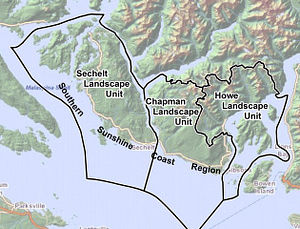At September 28, 2021 – A Briefing Document
For Protection Of A Proposed 2,137 Hectare Joint SHÍSHÁLH (Sechelt) – SḴWX̱ WÚ7MESH (Squamish) Indigenous Protected and Conserved Area (IPCA) or Other Full Protective Designation For The Mount Elphinstone Forest On The BC Sunshine Coast.
At February 12, 2021 – Dakota Bowl Bear Den Report-Final-12 Feb2021
Wayne McCrory, BSc (Hons. Zool.), RPBio, Bear biologist McCrory Wildlife Services Ltd – REVIEW OF BLACK BEAR DEN HABITAT & OTHER OLD GROWTH VALUES IN BC TIMBER SALES (BCTS) PLANNED TIMBER SALE LICENCE A87126 – DAKOTA COMMUNITY WATERSHED, SUNSHINE COAST FOREST DISTRICT, BC.
At February 9, 2021
FOR IMMEDIATE RELEASE: Feb 9, 2021
Study Supports More Forest Protection:
Lower Sunshine Coast Biodiversity at High Risk

Elphinstone Logging Focus (ELF) commissioned a report to examine recommendations made by the independent Old Growth Strategic Review Panel, and how those apply to the lower Sunshine Coast forests. The report, A GIS Analysis of the Sechelt, Chapman and Howe Landscape Units, concludes that a significant amount of forest in this region should be deferred from logging due to shockingly low levels of old-growth forest.
The Panel’s report A New Future for Old Forests: A Strategic Review of How B.C. Manages for Old Forests Within its Ancient Ecosystems (Gorley& Merkel, April 2020), makes many recommendations, including short-term deferrals for forest ecosystems with less than 10% old forest remaining, any ancient forests greater than 500 years old, and areas with a high potential to contribute towards ecosystem resilience. To unpack these technical issues, ELF hired Baden Cross of Applied Conservation GIS and had his findings reviewed by ecologist Dr. Karen Price and botanist Dr. Jim Pojar.
“All three Landscapes Units (LU) examined in this report are well below the 10% old-growth threshold the government Panel recommends for logging deferrals,” states Ross Muirhead of ELF. ”Of this region’s most common forest type, Coastal Western Hemlock dry maritime (CWHdm), the amount remaining is very low – only 4.6% in the Sechelt LU, 2.3% in the Chapman LU, and 3.6% in the Howe LU. Two cutblocks are planned by Sunshine Coast Community Forest in the even rarer Coastal Western Hemlock very dry maritime zone (Sechelt LU) where less
than 1% old-growth remains. Proposed cutblock HM 70 contains old-growth, and HM 50 is a native forest, not a tree plantation. Both should be conserved as Old Growth Management Areas to make up for this alarming deficit.”
”As our region is facing a severe deficit of old-growth forests, a critical conservation tool must be the recruitment of mature forests (120-160 years) so they can become the old-growth of our future.” Hans Penner of ELF states. “The job now is for government to step up and defer logging in all mature natural forests across this landscape, and bring these ecosystems back from the brink. Some of the last and best occurrences of mature CWHdm, are found at lower elevations in the proposed Mt. Elphinstone park expansion area. No more of it can be lost to
logging”
In utilizing all criteria for short-term logging deferrals outlined by the Old-growth Panel, a total of 3,755 ha of old (>250 yrs.) and ancient forest (>500 yrs.) should be considered for deferral in the three Landscape Units surveyed. If the more ecologically accurate definition of ancient forest as >400 years old is applied, as is recommended by the recently published report B.C.’s Old-Growth Forest: A Last Stand for Biodiversity (Price, Holt, and Daust, 2020), the total amount that should be deferred jumps to 7,313 ha of the total 15,594 ha of old and ancient
forest remaining in the three LUs.
The low and mid-elevation forests of the lower Sunshine Coast have so little old forest left that by the standards laid out by the Old-growth Panel, they are at “very high and near-term risk of irreversible biodiversity loss.” Biologist and forester Allen Banner states in his summary comments on the report “Most forested ecological communities at the lower elevations on the Sunshine Coast
are either red or blue-listed….and have little or no representation in the oldgrowth state.” Logging of additional mature and old forest in these zones should cease in the short term, and the best remaining examples of mature native forest conserved to rebuild the old-growth inventory and restore at-risk forest ecosystems. Additionally, the slow growing, high elevation ancient forests are irreplaceable and cannot be considered a renewable resource. They should never be logged.
We encourage First Nations, local and provincial government, and community stakeholders to utilize this report to conserve and restore our Sunshine Coast forest ecosystems where still possible. We need a paradigm shift in forest management now if we, our communities and the natural world that sustains us are to be resilient going forward in these times of climate and biodiversity crisis.
For a full copy of the report A GIS Analysis of the Sechelt,
Chapman and Howe Landscape Units, click on this link:
Read summary comments on the report from Allen Banner RPBio, RPF:
For further information contact:
Ross Muirhead
ELF Forest Campaigner
604-741-539
= = = =
To view in pdf/ printable format click below:
https://loggingfocus.org/wp-content/uploads/2021/02/PR-on-GIS-Analysis.pdf